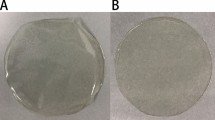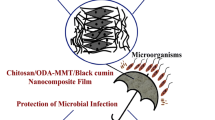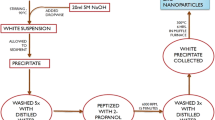Abstract
Sodium montmorillonite organically modified by octadecylammonium (Np-Clay) and zinc oxide nanoparticles (Np-ZnO) were incorporated into chitosan (C) matrix in different proportions to evaluate its mechanical properties and antimicrobial activities. The composites were obtained by polymer intercalation method in solution using acetic acid (1% v/v) as solvent. The functional groups, thermic behavior and surface morphology of the chitosan film and of the composites prepared with different percentages of Np-Clay and Np-ZnO were characterized through Fourier transform infrared spectroscopy (FTIR), thermogravimetric analysis (TGA), differential scanning calorimetry (DSC) and scanning electron microscopy (SEM). The results showed that a combined effect of clay and zinc oxide increases significantly the mechanical properties of pure chitosan. FTIR results confirmed good compatibility among functional groups of chitosan, montmorillonite/metallic oxides. The Np-ZnO distribution became more uniform in chitosan films when the Np-clay was incorporated, thus, the Np-Clay compatibilizes the Np-ZnO with the chitosan and the mechanical properties improved and without affecting the antimicrobial activity of the films. The thermal degradation temperature of the chitosan did not change significantly with the addition of Np-Clay, but changes significantly with Np-ZnO addition. In antimicrobial test was found that the chitosan and Np-ZnO showed a synergistic effect against to Escherichia coli and Staphylococcus aureus. The addition of Np-ZnO and C-Clay in chitosan resulted in enhancement of mechanical and antimicrobial properties, turning this material prospective for food packaging applications.
Graphical Abstract

















Similar content being viewed by others
References
Yoo J, Irvine DJ, Discher DE, Mitragotri S (2011) Bio-inspired, bioengineered and biomimetic drug delivery carriers. Nat Rev Drug Discov 10:521–535
López-Mata MA, Ruiz-Cruz S, de Jesús O-P et al (2018) Mechanical, barrier and antioxidant properties of chitosan films incorporating cinnamaldehyde. J Polym Environ 26:452–461
Rani S, Kumar R (2019) A review on material and antimicrobial properties of soy protein isolate film. J Polym Environ 27:1613–1628
Gutiérrez TJ (2018) Active and intelligent films made from starchy sources/blackberry pulp. J Polym Environ 26:2374–2391
Giunchedi P, Genta I, Conti B et al (1998) Preparation and characterization of ampicillin loaded methylpyrrolidinone chitosan and chitosan microspheres. Biomaterials 19:157–161
Rinaudo M (2006) Chitin and chitosan: properties and applications. Prog Polym Sci 31:603–632
Leceta I, Guerrero P, de la Caba K (2013) Functional properties of chitosan-based films. Carbohydr Polym 93:339–346
Ounkaew A, Kasemsiri P, Kamwilaisak K et al (2018) Polyvinyl alcohol (PVA)/starch bioactive packaging film enriched with antioxidants from spent coffee ground and citric acid. J Polym Environ 26:3762–3772
Alabaraoye E, Achilonu M, Hester R (2018) Biopolymer (Chitin) from various marine seashell wastes: isolation and characterization. J Polym Environ 26:2207–2218
Atangana E, Chiweshe TT, Roberts H (2019) Modification of novel chitosan-starch cross-linked derivatives polymers: synthesis and characterization. J Polym Environ 27:979–995
Cagri A, Ustunol Z, Ryser E (2004) Antimicrobial edible films and coatings. J Food Prot 67:833–848
Wu C, Li Y, Du Y et al (2019) Preparation and characterization of konjac glucomannan-based bionanocomposite film for active food packaging. Food Hydrocolloids 89:682–690
Haghighi H, De Leo R, Bedin E et al (2019) Comparative analysis of blend and bilayer films based on chitosan and gelatin enriched with LAE (lauroyl arginate ethyl) with antimicrobial activity for food packaging applications. Food Packag Shelf Life 19:31–39
Abdel Ghaffar AM, Ali HE, Nasef SM, El-Bialy HA (2018) Effect of gamma radiation on the properties of crosslinked chitosan nano-composite film. J Polym Environ 26:3226–3236
de Oliveira ACS, Ugucioni JC, da Rocha RA et al (2019) Chitosan/polyaniline conductive blends for developing packaging: electrical, morphological, structural and thermal properties. J Polym Environ. 27:2250
Otsubo Y, Kato C (1954) Hydrothermal synthesis of montmorillonite type silicates. III. synthesis of zinc-montmorillonite. J Chem Soc Jpn 75:456–459
Al-naamani L, Dobretsov S, Dutta J (2016) Chitosan-zinc oxide nanoparticle composite coating for active food packaging applications. Innov Food Sci Emerg Technol 38:231–237
Cabuk M, Alan Y, Unal HI (2017) Enhanced electrokinetic properties and antimicrobial activities of biodegradable chitosan/organo-bentonite composites. Carbohydr Polym 161:71–81
Sanuja S, Agalya A, Umapathy MJ (2015) Synthesis and characterization of zinc oxide–neem oil–chitosan bionanocomposite for food packaging application. Int J Biol Macromol 74:76–84
Li L-H, Deng J-C, Deng H-R et al (2010) Synthesis and characterization of chitosan/ZnO nanoparticle composite membranes. Carbohydr Res 345:994–998
Salari M, Sowti Khiabani M, Rezaei Mokarram R et al (2018) Development and evaluation of chitosan based active nanocomposite films containing bacterial cellulose nanocrystals and silver nanoparticles. Food Hydrocolloids 84:414–423
Kumar S, Shukla A, Baul PP et al (2018) Biodegradable hybrid nanocomposites of chitosan/gelatin and silver nanoparticles for active food packaging applications. Food Packag Shelf Life 16:178–184
Abdollahi M, Rezaei M, Farzi G (2012) A novel active bionanocomposite film incorporating rosemary essential oil and nanoclay into chitosan. J Food Eng 111:343–350
Deng H, Lin P, Xin S et al (2012) Quaternized chitosan-layered silicate intercalated composites based nanofibrous mats and their antibacterial activity. Carbohydr Polym 89:307–313
Vlacha M, Giannakas A, Katapodis P et al (2016) On the efficiency of oleic acid as plasticizer of chitosan/clay nanocomposites and its role on thermo-mechanical, barrier and antimicrobial properties—comparison with glycerol. Food Hydrocolloids 57:10–19
Ambre AH, Katti KS, Katti DR (2010) Nanoclay Based composite scaffolds for bone tissue engineering applications. J Nanotechnol Eng Med 1:031013
Macuvele DLP, Colla G, Cesca K et al (2019) UHMWPE/HA biocomposite compatibilized by organophilic montmorillonite: An evaluation of the mechanical-tribological properties and its hemocompatibility and performance in simulated blood fluid. Mater Sci Eng C 100:411–423
Jiménez A, Roxana Ruseckaite RA (2012) Environmental silicate nano-biocomposites. Springer, Berlin, p 393
Rhim JW, Wang LF, Hong SI (2013) Preparation and characterization of agar/silver nanoparticles composite films with antimicrobial activity. Food Hydrocolloids 33:327–335
Souza VGL, Pires JRA, Vieira ÉT et al (2019) Activity of chitosan-montmorillonite bionanocomposites incorporated with rosemary essential oil: From in vitro assays to application in fresh poultry meat. Food Hydrocolloids 89:241–252
Qin Y, Liu Y, Yuan L et al (2019) Preparation and characterization of antioxidant, antimicrobial and pH-sensitive films based on chitosan, silver nanoparticles and purple corn extract. Food Hydrocolloids 96:102–111
Priyadarshi R, Negi YS (2017) Effect of varying filler concentration on zinc oxide nanoparticle embedded chitosan films as potential food packaging material. J Polym Environ 25:1087–1098
Blasco C, Picó Y (2011) Determining nanomaterials in food. TrAC, Trends Anal Chem 30:84–99
Katti KS, Katti DR, Dash R (2008) Synthesis and characterization of a novel chitosan/montmorillonite/ hydroxyapatite nanocomposite for bone tissue engineering. Biomed Mater 3:034122
Motshekga SC, Sinha S, Onyango MS, Momba MNB (2015) Preparation and antibacterial activity of chitosan-based nanocomposites containing bentonite-supported silver and zinc oxide nanoparticles for water disinfection. Appl Clay Sci 114:330–339
Müller L (2013) Incorporação de óleo essencial de cravo em membranas de quitosana e avaliação da atividade antimicrobiana e cicatrizante. Universidade Federal de Santa Catarina
Signini R, Campana Filho SP (1998) Purificação e caracterização de quitosana comercial. Polímeros 8:63–68
Massinga PH, Focke WW, de Vaal PL, Atanasova M (2010) Alkyl ammonium intercalation of Mozambican bentonite. Appl Clay Sci 49:142–148
Macuvele DLP, Nones J, Matsinhe JV et al (2017) Simultaneous effect of reaction temperature and concentration of surfactant in organo-bentonite synthesis. Mater Sci Forum 899:42–47
Siripatrawan U, Harte BR (2010) Physical properties and antioxidant activity of an active film from chitosan incorporated with green tea extract. Food Hydrocolloids 24:770–775
Brugnerotto J, Lizardi J, Goycoolea F et al (2001) An infrared investigation in relation with chitin and chitosan characterization. Polymer 42:3569–3580
Sanuja S, Agalya A, Umapathy MJ (2014) Studies on magnesium oxide reinforced chitosan bionanocomposite incorporated with clove oil for active food packaging application. Int J Polym Mater Polym Biomater. https://doi.org/10.1080/00914037.2013.879445
Wang X, Du Y, Yang J et al (2006) Preparation, characterization and antimicrobial activity of chitosan/layered silicate nanocomposites. Polymer 47:6738–6744
Szymanska E, Winnicka K (2015) Stability of chitosan- A challenge for pharmaceutical and biomedical applications. Marine Drugs 13:1819–1846
Kittur FS, Harish Prashanth KV, Udaya Sankar K, Tharanathan RN (2002) Characterization of chitin, chitosan and their carboxymethyl derivatives by differential scanning calorimetry. Carbohydr Polym 49:185–193
Martins CS, Morgado DL, Benedito O, Assis G (2016) Cashew gum-chitosan blended films:spectral, mechanical and surface wetting evaluations. Macromol Res 24:691–697
Ma X, Zhang W (2009) Effects of flower-like ZnO nanowhiskers on the mechanical, thermal and antibacterial properties of waterborne polyurethane. Polym Degrad Stab 94:1103–1109
Chrissafis K, Bikiaris D (2011) Can nanoparticles really enhance thermal stability of polymers? Part I: an overview on thermal decomposition of addition polymers. Thermochim Acta 523:1–24
Sakurai K, Maegawa T, Takahashi T (2000) Glass transition temperature of chitosan and miscibility of chitosan/poly(N-vinyl pyrrolidone) blends. Polymer 41:7051–7056
El-Hefian EA, Nasef MM, Yahaya AH (2011) Preparation and characterization of chitosan/poly(vinyl alcohol) blended films: Mechanical, thermal and surface investigations. E J Chem 8:91–96
Azizi S, Ahmad MB, Ibrahim NA et al (2014) Cellulose nanocrystals/ZnO as a bifunctional reinforcing nanocomposite for poly(vinyl alcohol)/chitosan blend films: fabrication, characterization and properties. Int J Mol Sci 15:11040–11053
da Silvano JR, Santa RAAB, Martins MAPM et al (2018) Nanocomposite of erucamide-clay applied for the control of friction coefficient in surfaces of LLDPE. Polym Test 67:1–6
Tianwei T, Xiaojing H, Weixia D (2001) Adsorption behaviour of metal ions on imprinted chitosan resin. J Chem Technol Biotechnol. https://doi.org/10.1002/jctb.358
Hu SG, Jou CH, Yang MC (2003) Protein adsorption, fibroblast activity and antibacterial properties of poly(3-hydroxybutyric acid-co-3-hydroxyvaleric acid) grafted with chitosan and chitooligosaccharide after immobilized with hyaluronic acid. Biomaterials 24:2685
Muñoz-Bonilla A, Fernández-García M (2012) Polymeric materials with antimicrobial activity. Prog Polym Sci 37:281–339
Shao WF, Chin FL, Daniel S (1994) Antifungal activity of chitosan and its preservative effect on low sugar candied Kumquat. J Food Prot 57:136–140
Han Y-S, Lee S-H, Choi KH, Park I (2010) Preparation and characterization of chitosan–clay nanocomposites with antimicrobial activity. J Phys Chem Solids 71:464–467
Jung B-O, Kim C-H, Choi K-S et al (1999) Preparation of amphiphilic chitosan and their antimicrobial activities. J Appl Polym Sci 72:1713–1719
Acknowledgements
This research was funded by the Foundation for Support to Scientific and Technological Research of Santa Catarina State – FAPESC, CAPES and CNPq.
Author information
Authors and Affiliations
Corresponding author
Ethics declarations
Conflict of interest
The authors declare that they have no conflicts of interest.
Additional information
Publisher's Note
Springer Nature remains neutral with regard to jurisdictional claims in published maps and institutional affiliations.
Rights and permissions
About this article
Cite this article
Rodrigues, C., de Mello, J.M.M., Dalcanton, F. et al. Mechanical, Thermal and Antimicrobial Properties of Chitosan-Based-Nanocomposite with Potential Applications for Food Packaging. J Polym Environ 28, 1216–1236 (2020). https://doi.org/10.1007/s10924-020-01678-y
Published:
Issue Date:
DOI: https://doi.org/10.1007/s10924-020-01678-y




